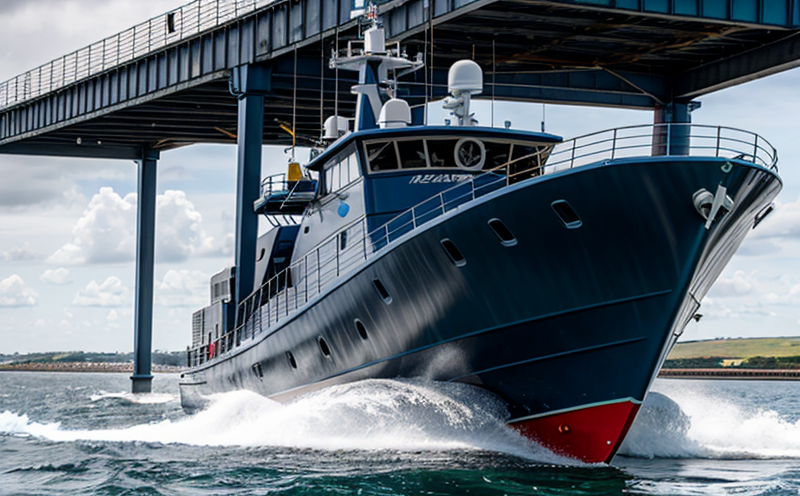ISO 3746 Noise Emission Testing of Ship Propulsion Systems
The ISO 3746 standard provides a comprehensive framework for the measurement and evaluation of noise emitted by ship propulsion systems. This service ensures compliance with international regulations, enhancing safety and reducing environmental impact in maritime operations.
Marine engines and propulsion systems are critical components that contribute to the overall efficiency and performance of ships. However, they also generate significant levels of noise which can be detrimental to crew health and wellbeing as well as the marine ecosystem if not properly managed. The ISO 3746 test focuses on quantifying these emissions using scientifically validated methods, thereby facilitating informed decision-making processes within shipyards and fleet operators.
Our laboratory adheres strictly to ISO standards when conducting this type of testing. Our team utilizes advanced acoustic equipment capable of capturing detailed data at various points around the engine room and throughout the vessel. By doing so, we ensure accurate measurements that can be used for both regulatory compliance purposes as well as internal quality control initiatives.
The process begins with thorough preparation of the propulsion system to be tested according to established guidelines laid out in the ISO 3746 specification document. This includes ensuring all components are functioning correctly and have been properly installed before testing commences. Once ready, our engineers deploy a series of calibrated microphones placed strategically around the engine room to capture sound waves emitted by different parts of the system.
Instrumentation plays a crucial role in gathering precise data during ISO 3746 noise emission tests for ship propulsion systems. We use state-of-the-art acoustic analyzers equipped with high-frequency sensors designed specifically for measuring low-level sounds produced by machinery such as engines and generators. These devices allow us to monitor both frequency bands (A-weighted vs C-weighted) over extended periods, providing a holistic view of the noise environment aboard vessels.
In addition to capturing raw sound pressure levels, our lab also employs advanced signal processing techniques to analyze recorded data sets further. This helps identify specific sources contributing most significantly towards overall noise levels within the engine room area. Such insights are invaluable for identifying potential areas where improvements could be made either through design changes or operational adjustments.
After collecting all necessary information, our experts apply internationally recognized standards such as ISO 3746 to interpret results and determine whether they meet specified limits set forth by relevant authorities like IMO (International Maritime Organization). Compliance with these guidelines ensures that ships operate safely without causing undue harm either to personnel onboard or surrounding waters.
Our commitment extends beyond mere compliance; we strive to provide actionable intelligence derived from our findings. Through detailed reports and recommendations tailored specifically for each customer, we help them optimize their operations while minimizing environmental impact. Whether you're a shipyard looking to enhance product quality or an existing fleet operator aiming to improve sustainability practices – our ISO 3746 noise emission testing services offer valuable insights into your current situation.
By embracing this standard, organizations can demonstrate their commitment to responsible maritime practices and contribute positively towards creating healthier working environments for seafarers. At the same time, they ensure that their vessels remain compliant with international regulations without compromising on performance or efficiency.
Scope and Methodology
- Measurement Points: Multiple strategic locations around the engine room are identified for microphone placement to capture sound waves accurately.
- Instrumentation: Advanced acoustic analyzers equipped with high-frequency sensors designed specifically for measuring low-level sounds produced by machinery like engines and generators.
- Data Interpretation: Applying internationally recognized standards such as ISO 3746 to determine whether noise levels meet specified limits set forth by relevant authorities like IMO (International Maritime Organization).
The scope of our service includes not only the technical aspects but also involves close collaboration with clients throughout every stage of testing. From initial planning through final report generation, we maintain open communication channels ensuring that all parties involved are kept informed about progress and any issues encountered along the way.
Why Choose This Test
Adhering to ISO 3746 noise emission testing standards is essential for several reasons:
- Regulatory Compliance: Ensures your ship complies with international regulations, which is crucial for avoiding fines and penalties.
- Safety: Reduces risks associated with excessive noise levels that could lead to hearing damage among crew members.
- Eco-Friendly Operations: Minimizes environmental impact by ensuring noise emissions do not exceed permissible limits set forth by regulatory bodies.
- Enhanced Reputation: Demonstrates your organization's commitment to responsible maritime practices, enhancing brand image and reputation.
In today’s competitive market, maintaining high standards of safety and sustainability is key. By choosing our ISO 3746 noise emission testing service, you are investing in the future success of your business while contributing positively towards a healthier working environment for all involved.
Quality and Reliability Assurance
Ensuring accurate and reliable test results is paramount when it comes to ISO 3746 noise emission testing of ship propulsion systems. Our laboratory employs rigorous quality control measures at every stage of the process, from equipment calibration through data analysis.
- Equipment Calibration: All instruments used are regularly calibrated against national and international standards to ensure precision.
- Data Verification: Multiple checks are conducted on collected data sets to verify accuracy before interpretation begins.
- Repeatability: Tests are repeated under identical conditions whenever possible, allowing for consistent results over time.
We understand the importance of reliability in our testing procedures. That’s why we maintain strict adherence to ISO 3746 guidelines throughout each project. By doing so, we guarantee that every measurement taken is accurate and can be trusted as a reflection of true noise levels within your vessel's engine room.





